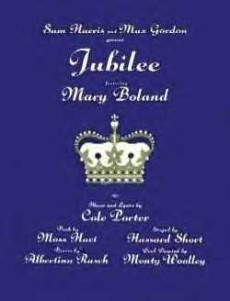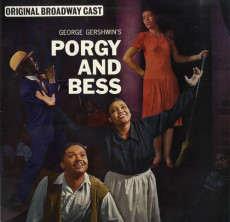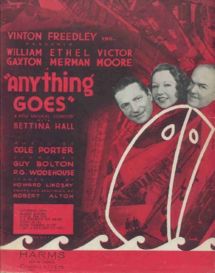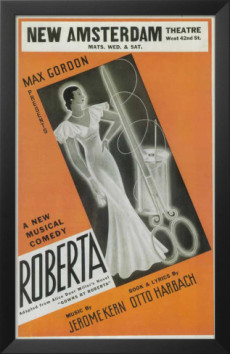
From Broadway To 52nd Street
The Imperial Theatre aptly opened Jubilee on October 25, 1935 with music composed by Cole Porter and starring Melville Cooper, Mary Boland, Charles Walter and Margaret Adams. Running for 169 performances, entering into the jazz lexicon are two songs from the musical, Begin The Beguine and Just One Of Those Things.
The Story: Set approaching the anniversary of the coronation and the King and Queen admit they have become jaded with their luxurious but constrained life and Prince James & Princess Diana agree. When a royal nephew leads an insurrection, the royal family rushes into seclusion and emerges incognito. The queen flirts with a movie star, the princess has an affair with a writer and the prince takes a celebrated dancer out on the town. The king is happy to remain at home playing his beloved parlor games. Inevitably they are recognized, so when the insurrection dies, the royal family returns to its comfortable restricted world.
Broadway History: The first decade of the century witnessed the creation of numerous theatres in the new Longacre Square area, and, in 1902 when the Hotel Pabst was razed to allow the Times Building to be built on that spot, Longacre Square became Times Square. New theatres in the area included the Victoria at 42nd & 7th built in 1899; the Republic on 42nd built in 1900;; The Lyric and The New Amsterdam both a few doors down built in 1903. The following year the Lew Fields Theatre was built on the same block. There were several others built in the area from 39th to 45th streets, and some enterprising individuals were progressing even further uptown to Columbus Circle and Central Park West.
In 1900, Broadway (the Broadway we’re interested in) extended from The Star Theatre on 13th Street to the New York Theatre on 45th Street and patrons were paying $1.50 to $2.00 each for the best seats to see their favorite stars.
Sponsored By
www.whatissuitetabu.com
More Posts: broadway

From Broadway To 52nd Street
Porgy & Bess took the stage at the Alvin Theatre on October 10, 1935, running for only 124 performances. Written by Dubose Hayward with music composed by the Gershwins, and starred Todd Duncan, Anne Wiggins Brown, Warren Coleman and John W. Bubbles. The initial production was treated as such a major event that the larger dailies sent both their drama and music critics to cover the opening. Though not a commercial success from the ashes rose a score that has been performed by countless musicians but a few songs separated themselves to become individual classics and jazz standards such as Summertime, I Loves You Porgy, My Man’s Gone Now, It Ain’t Necessarily So, and There’s A Boat That Leaving Soon.
The Story: Set in Charleston, South Carolina in the tenements of Catfish Row, this opera follows the lives of Porgy, a crippled beggar, his love interest – the seductive Bess, her abusive man Crown and the slinky cocaine dealer Sportin’ Life who woos her away to New York City. The star-crossed lovers, Porgy and Bess, are doomed to struggle but triumph with dreams of life outside their community.
Broadway History: But while New Yorkers were enjoying the distraction of Broadway, the country remained engulfed in The Great Depression and in year five of the Dust Bowl’s “Dirty Thirties” in which the year hosted on April 14th the worst “black blizzard” causing such extensive soil erosion that would come to be known as Black Sunday. Some 5.3 million acres of the Southern Plains were damaged and the dust would blow all the way to east coast.
However, while part of the country was experiencing disaster Ella Fitzgerald was winning a one week performance at the Harlem Opera House, the “Swing Era” was in its infancy, Benny Goodman has secured a recording contract with Victor Records and snagged a spot on the Let’s Dance radio program and a live broadcast of his Palomar Ballroom performance in Los Angeles garnered him national following and a first-ever jazz concert at Carnegie Hall in New York. Tommy Dorsey would follow with a million-seller record with Irving Berlin’s Marie along with Artie Shaw’s version of Cole Porter’s Begin The Beguine.
Sponsored By
www.whatissuitetabu.com
More Posts: broadway

From Broadway To 52nd Street
Anything Goes opened at the Alvin Theater on November 21, 1934 and had a run of 420 performances. Cole Porter wrote the music for the show and it featured such stars as Ethel Merman, William Gaxton and Bettina Hall. From the musical I Get A Kick Out Of You is singled out for fame and applause as a jazz standard.
The Story: Reno Sweeney, an evangelist turned bar hostess gets such a kick out of Billy Crocker that she boards a Europe bound liner to dissuade him from pursuing Hope Harcourt. Crocker, aboard without a ticket must adopt several disguises. Hope loves an Englishman of her peer. Rev. Dr. Moon is on J. Edgar Hoover’s public enemy list at #13 and attempting to rise to #1. Reno holds a revival; Hope becomes an heiress, drops her Englishman and consents to marry Crocker. Moon gets dropped from Hoover’s list.
Broadway History: In the 1900-01 season there were seventy plays or musicals being produced on Broadway. It was the beginning of the boom and the decades that followed saw the number of plays produced quadruple. In addition, there were seven vaudeville houses and six burlesque theaters presenting their shows to a theatre thirsty population of just over three and a half million inhabitants.
The first decade of the 20th century was both boring and transformational in the history of Broadway. The seeds of that transformation go back to 1882 with the construction of The Madison Square Theatre at 24th Street. At the time, the theatre district was concentrated between Union Square and 24th Street.
More Posts: broadway

From Broadway To 52nd Street
Roberta opened at the New Amsterdam Theater on November 11, 1933. It ran 295 performances with music by Jerome Kern, and lyrics and book by Otto Harbach. The show starred Tamara Drasin, Bob Hope, George Murphy, Ray Middleton, Fay Templeton and Fred MacMurray. The musical comedy was based on the novel Gowns by Roberta by Alice Duer Miller and is set in a fraternity house at Haverhill College. From the play came songs like Yesterdays, Smoke Gets In Your Eyes and The Touch Of Your Hand that have become jazz standards.
The Story: Set in a fraternity house at Haverhill College: A deposed Russian princess has become a famed Parisian couturier. Her partner passes away leaving her half of the business to American football player Randolph Scott–who of course knows next to nothing about the gown business, and couldn’t care less anyway. The former girlfriend of the bandleader poses as a phony Polish countess. Men are chasing women who are chasing men as flirtations involved all.
Jazz History: By the time Roberta premiered on Broadway, the nation was buckling under the devastation of The Great Depression. Twenty-five percent of the workforce was jobless, and up to 60 percent of African American men had no work. Cities became crowded with people searching for work after farms began to whither and rot. Black musicians were not allowed to do studio or radio work. However, jazz music was resilient. While businesses, including the record industry, were failing, dance halls were packed with people dancing the jitterbug to the music of big bands, which would come to be called swing music.
Swing bands attracted throngs with their intensity, playing fast and loud blues riffs and featuring virtuosic soloists. All of a sudden, thanks to musicians such as Coleman Hawkins, Lester Young and Ben Webster, the tenor saxophone became the instrument most strongly identified with jazz.
In Kansas City, pianist Count Basie began building an all-star big band after Benny Moten, a well-known bandleader died in 1935. Basie featured Lester Young, giving rise to the saxophonist’ career as an innovator, and also bringing exposure to an aggressive and bluesy vein of jazz that filled the clubs of the Midwest.
Sponsored By
www.whatissuitetabu.com
More Posts: broadway

From Broadway To 52nd Street
In the thirties one name was destined for stardom and it belonged to Ethel Waters. Growing up in a solitary and restless childhood in Philadelphia’s poor and violent 8th Ward, she quickly became distrustful of authority, wary of kindness or commitment but connected to the songs “her people” sang and the stories they carried with them. She began singing in black nightclubs and the on the Chitlin’ Circuit, belting out gutsy and raunchy songs delivered with impeccable diction.
Debuting on Broadway in an unsuccessful revue called Africana, she soon was playing Rhapsody in Black making an unprecedented $2500 a week. But it was a gig in Harlem’s Cotton Club in 1933 where she introduced a Harold Arlen/Ted Koehler tune Stormy Weather that brought her unique talents to a wider audience. Irving Berlin was in the audience and when he heard Ethel, he knew she was right for one of the bravest range of songs ever produced on Broadway.
A revue cleverly tied together by the device of pretending that each song and skit was derived from headlines in one imaginary newspaper, was the basis for a new musical, As Thousands Cheer. It opened on September 30, 1933 at the Music Box and held the stage for 400 consecutive performances.
But it was Irving Berlin who brought a vibrant and exciting young singer named Ethel Waters downtown from Harlem and centered two songs composed by Berlin that went on to establish themselves in jazz history. The first headline simply said “Heat Wave” in which a young woman starts a heat wave by letting her seat wave! The second headline read: Unknown Man Lynched By Frenzied Mob and behind Ethel Waters was the silhouette of a man with a rope around his neck hanging from a tree as she sang “Supper Time”.
Sponsored By
www.whatissuitetabu.com
More Posts: broadway


